Regional Exploration
Kairos's flagship Mt York Gold Deposit is an advanced gold project at the scoping study stage. Aggressive drilling and resource expansion is planned over a pipeline of neighbouring prospects, including the recently acquired gold and base metal rights to the 1,500m of strike length of the Main Trend Deposit. This is truly a Tier 1 gold project hosted in Archaean Banded Iron Formation (BIF) rocks, with huge exploration and resource upside in an area supported by excellent infrastructure.
All Kairos’s Western Australian exploration projects cover Archaean rocks that are known around the world to be prolifically mineralised with big deposits of gold, nickel, copper-lead-zinc deposits and recognised as hosting the largest hard-rock deposits of valuable Lithium minerals, notably spodumene, in Lithium-Caesium-Tantalum (LCT) pegmatites.
Kairos is using state-of-the-art satellite imagery processing and interpretation across its portfolio as a first-pass exploration technique to highlights areas of significant alteration that often accompany major mineralisation. Follow-up mapping, sampling and drilling are part of the exploration workflow to advance each project.
Kairos has an enviable land position in both the Pilbara and Eastern Goldfields.
In the Pilbara, Kairos has 1,288 km2 of granted licences and a further 565 km2 of applications (total tenure of 1,853 km2) covering highly prospective greenstone belt geology that has not been the subject of any previous exploration. The licences cover strategic granite-greenstone boundaries along-strike of known gold and lithium mineral deposits and mines.
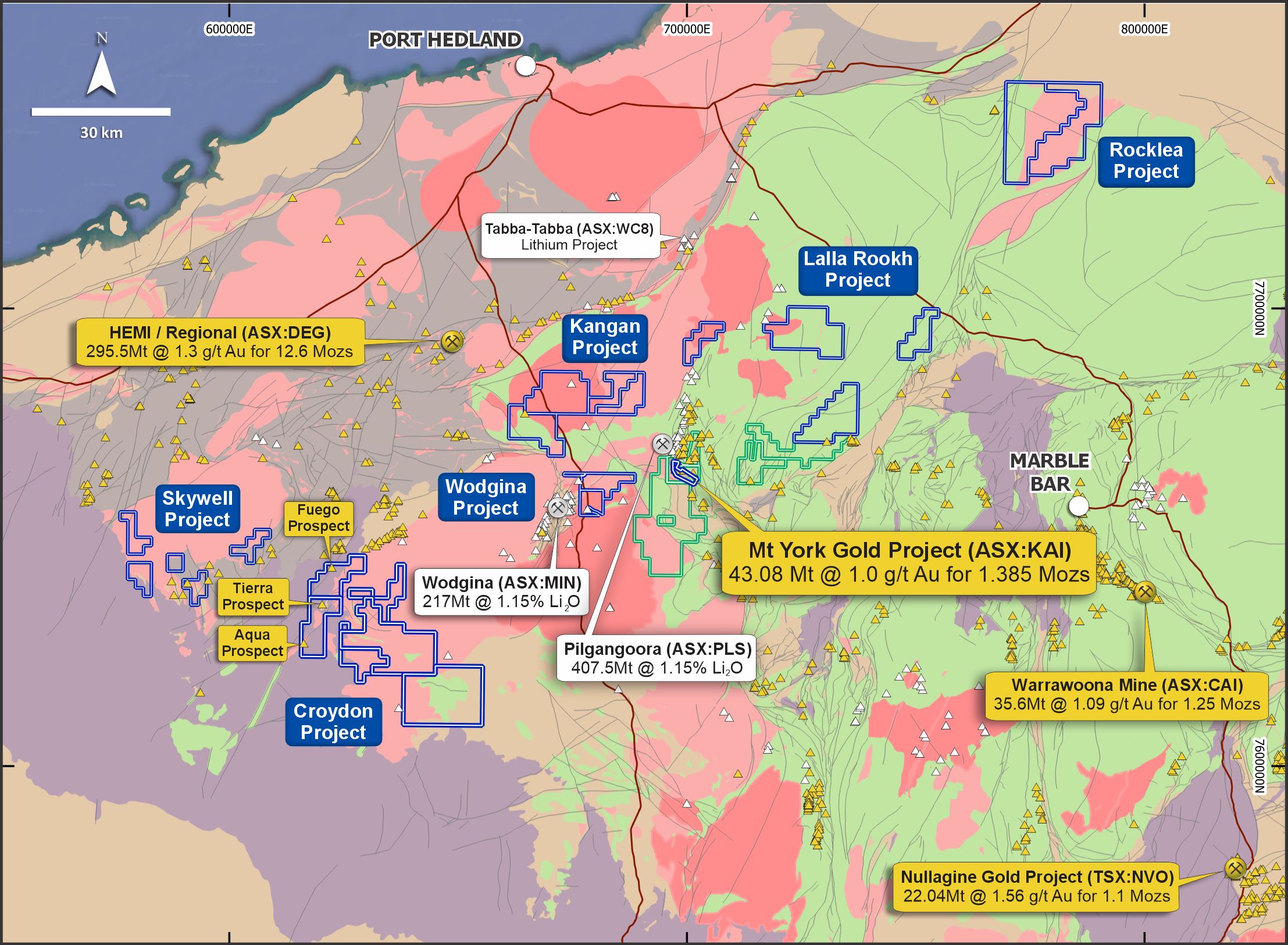
Figure 1. Kairos 100% owned tenements in the Pilbara of Western Australia in relation to known gold and lithium occurrences and mines.
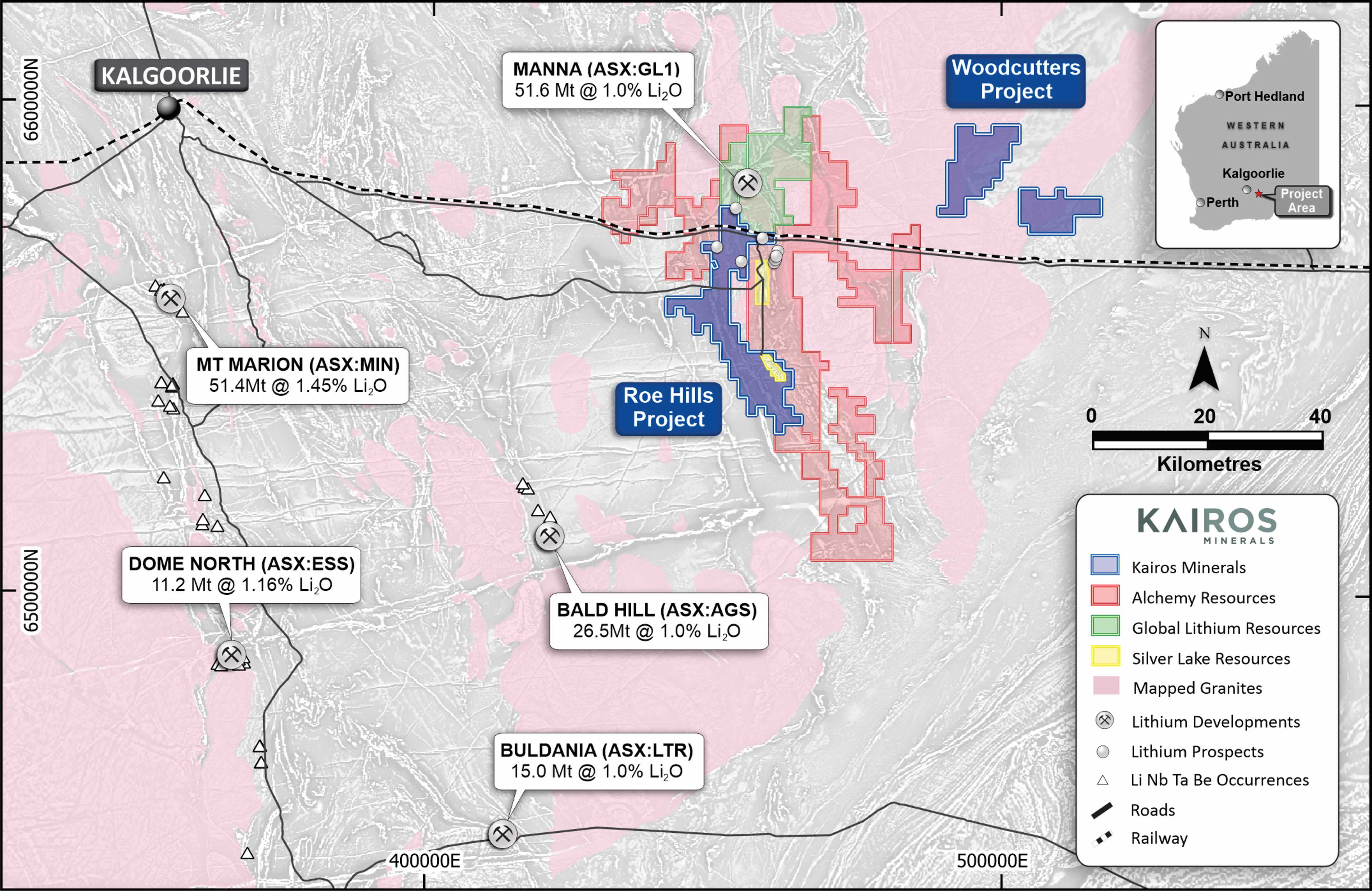
Figure 2. Roe Hills and Woodcutters Projects, Eastern Goldfields showing the most advanced lithium projects in the area.
Kairos’s Roe Hills Project is a contiguous group of licences and applications covering 409 km2 of greenstone belt volcanics, sediments and neighbouring granites in the Yilgarn craton offering Kairos 48 km of strike along known occurrences of gold, nickel, cobalt and lithium.
The following are project descriptions of Kairos’s most advanced regional exploration projects. More recent information on project results can be found under our Investor Centre – ASX Announcement tab.
Pilbara Projects
Croydon Project (Kairos 100%)
The Croydon Project covers the southwestern end of a large Sisters Supersuite Granite and has a string of large-scale gold and lithium soil anomalies over exciting structural features. The project provides the opportunity to discover intrusion-related gold deposits as is seen at the Hemi deposit owned by De Grey Mining and new spodumene-pegmatites that are manifest as lithium soil anomalies.
Soil geochemical anomalies defined by Kairos’ pioneering sampling over part of the licence, particularly the granite-basin margin, gives confidence of the scale and tenor of gold targets to make a significant discovery once drilling is undertaken. Many of these prospects have associated gold nuggets that have been detected in nearby drainage, leading to more signs of gold mineralisation in the area.
The new gold targets are called Fuego (Fire), Tierra (Earth), Aqua (Water) and Viento (Wind). There are four new lithium targets – one at Tierra (Figure 4) and the others called the ‘Eastern Targets’ for the moment.
The Tierra and Eastern 1 lithium targets show similar geological settings to the Mt Cassiterite pegmatite suite, part of the 259Mt @ 1.17%Li2O deposit owned by Mineral Resources and Albemarle Corporation (ASX: MIN and NYSE: ALB). The Tierra Lithium anomaly is a Priority 1 target (Figure 4).
The targets have been identified by the successful multi-element geochemical sampling program with 1,304 soil samples collected and submitted for Ultrafine+™ analysis at the Labwest Laboratory in Perth.
Kairos has also completed the in-fill soil sampling program at Tierra and Aqua prospects, with targets now ready to be field-checked and drill-tested.
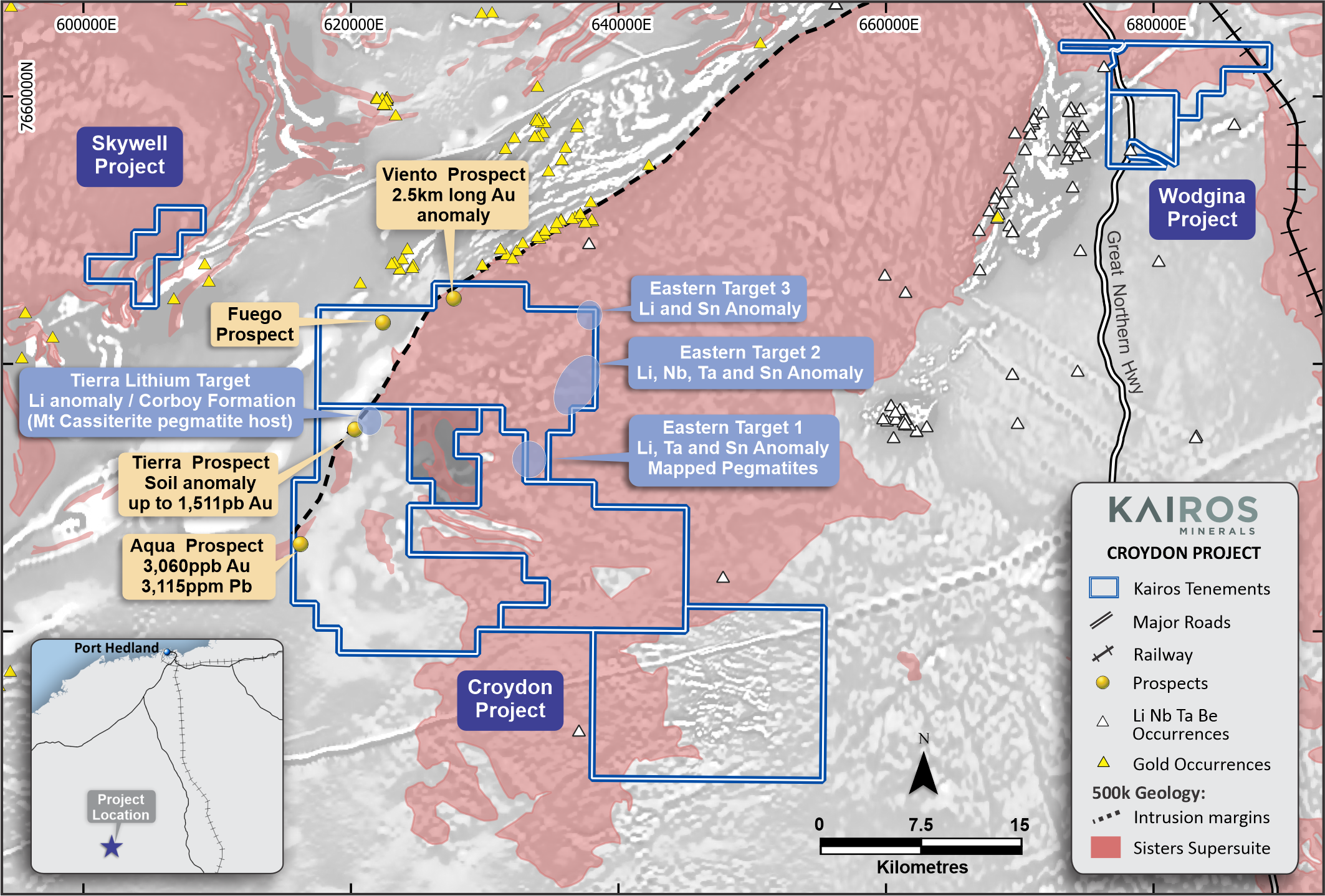
Figure 3. Croydon geophysical-geology map showing the gold and lithium prospects.
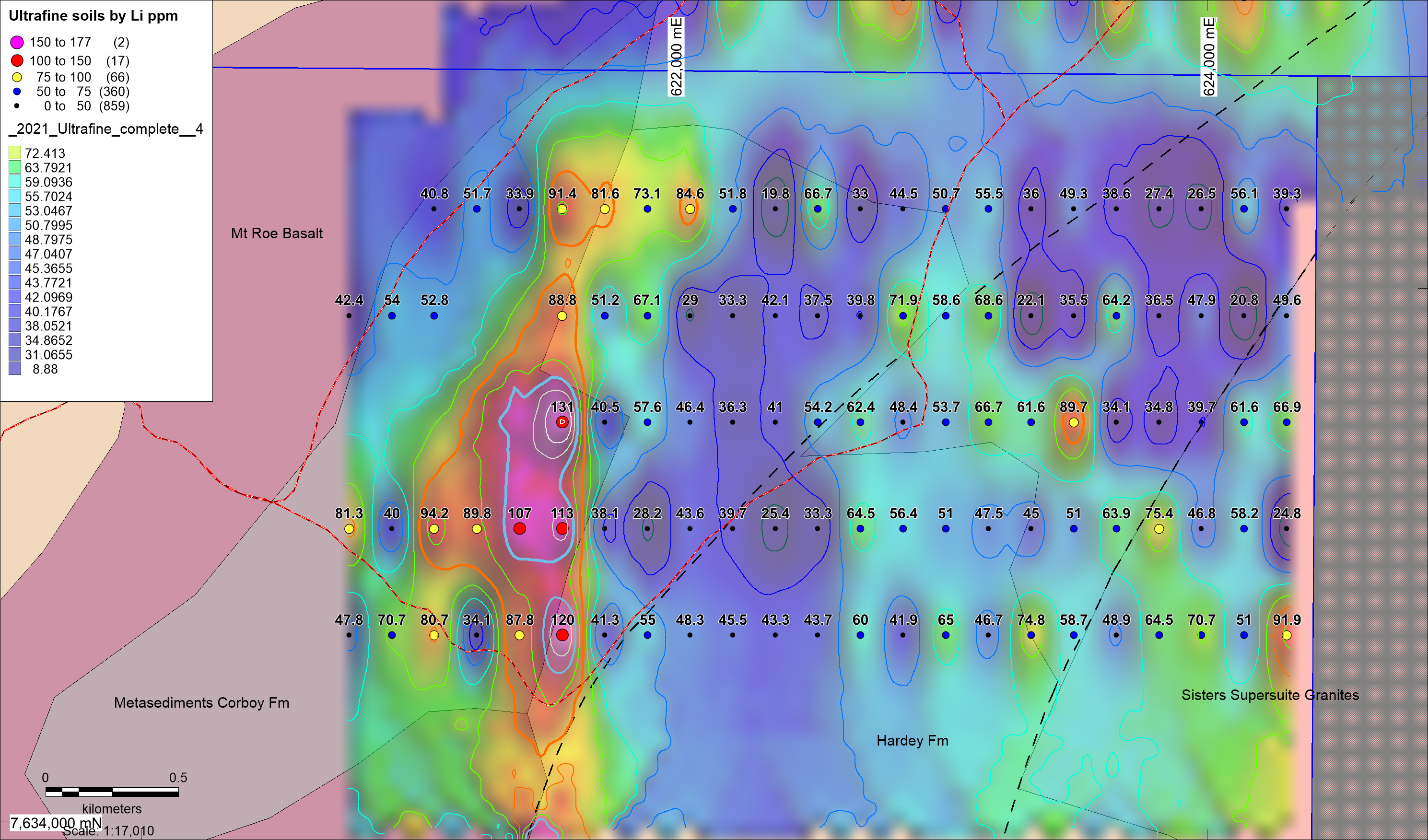
Figure 4. Croydon Project, Tierra Lithium soil target ready for full field evaluation, sampling and drilling.
Wodgina (Kairos 100%)
The Wodgina Project comprises two granted Exploration Licences E45/4715 and E45/4780, covering an area of 68 km2. The Project is located ~90km south of Port Hedland and is situated immediately adjacent to Mineral Resources’ (ASX: MIN) Wodgina lithium-tantalum mine and ~15km from Pilbara Minerals’ (ASX: PLS) Pilgangoora lithium-tantalum mine.
Kairos recently completed an Ultrafine+ soil sampling program at Wodgina Project, with 1,517 samples submitted to Labwest in Perth for gold and multi-element analysis. The soil sampling program was designed to test areas prospective for lithium-enriched pegmatites and for gold at the margins of the Sisters Supersuite intrusion. An airborne magnetic and radiometric survey comprising 435 lines for 2,387km has been completed across the Wodgina Project area.
Heritage surveys are currently underway over the lithium anomalies with drilling anticipated once done.
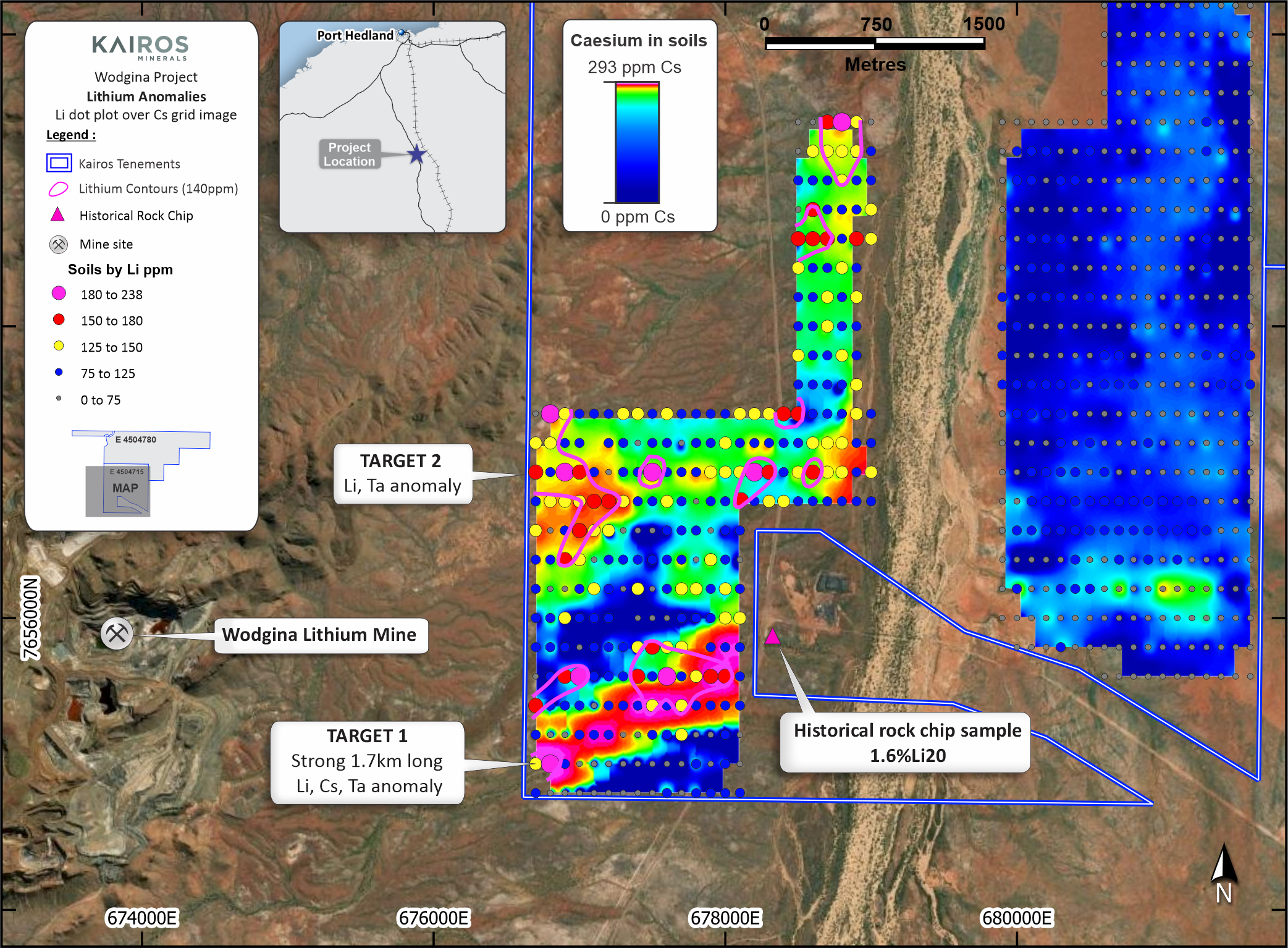
Figure 5. Wodgina lithium anomalies pending drill confirmation.
Skywell, Kangan, Lalla Rookh & Rocklea (Kairos 100%)
Kairos has pegged a number of exploration licences that are at different stages of granting and exploration maturity. They were all pegged on the premise of good geology and exciting prospectivity for both lithium and gold.
A full review of each of the licences is underway with field visits planned to understand the best exploration techniques to be used for lithium and gold exploration. Remote sensing techniques are used as a routine tool for determining the presence of alteration systems and lithium-caesium-tantalum (LCT) pegmatite occurrences.
Where soil anomalies are evident, drilling will be reviewed as the natural progression of exploration testing. Heritage surveys are part of this process with Native Title Claimants, and Kairos is always pleased to engage with the Aboriginal Peoples and Traditional Owners over which are exploration titles occur.
Kairos will update exploration progress as results become available.
Roe Hills (Kairos 100%)
The Roe Hills Project is composed of 19 granted, contiguous exploration licences located 120km east of Kalgoorlie within the Kurnalpi Terrane of the Eastern Goldfields, eastern Yilgarn Craton (EYC) in a rapidly emerging gold province. The area is currently enjoying a significant level of exploration activity and investor interest from both the gold and lithium sector companies after the Manna Lithium Deposit was discovered by Breaker Resources (ASX:BRB) and later acquired by Global Lithium (ASX:GL1)(Figure 6).
Kairos’s tenure encompasses a dominant land-holding in the area comprising a total of 352.7 km2 and securing a 48 km continuous strike length of the interpreted southern extensions of the highly prospective Leonora-Laverton greenstone belts, host to numerous significant historical and current gold mines in WA. The Roe Hills Project is located in a structurally and geologically complex area, adjacent to the regionally significant Keith-Kilkenny Shear zone, host to Breaker Resources Ltd (ASX: BRB) Bombora Gold Project (32 Mt at 1.6g/t Au for 1.7 moz) and Silver Lake Resources (ASX: SLR) Aldiss Project (9.3 Mt at 2.0g/t Au for 595 koz), which includes the operating Harrys Hill and French Kiss open cut mines (Figure 6).
The focus of Kairos’s attention is the potential to host a significant lithium (spodumene) deposit over its prospective tenements. The recent discovery and resource drilling of the Manna Lithium Deposit 10 km north of Kairos’s Black Cat Lithium-Caesium-Tantalum coincident soil anomaly (Figure 7) has promoted the Roe Hills area as a new lithium province.
Kairos has also completed extensive auger sampling and uncovered many new gold anomalies worthy of drill-testing (Figure 8).
Significant, recent drill hits of 8m @ 1.32 g/t Au from 32m including 4m @ 2.29 g/t Au from 36m (RHRC105) at the Caliburn Prospect indicate that the southern half of the Roe Hills package could host a series of gold occurrences occupying a major splay off the Keith-Kilkenny (Aldiss) Fault, along a significant strike length.
In addition to its exciting gold potential, the Roe Hills Project also shows compelling discovery opportunities for cobalt and nickel.
A review of historical drill data completed in 2017 identified potentially significant cobalt mineralisation within an extended geochemically anomalous footprint at the ROE-1 prospect, including an historical high-grade cobalt intercept of 14m @ 0.39% Co from 20m, including 2m @ 1.16% Co from 20m.
Cobalt mineralisation at ROE-1 (>0.05% Co) extends over a strike length of at least 330m, a width of at least 150m and a thickness in excess of 8m. Importantly, this zone occurs within a broader area of cobalt anomalism which can be traced over a strike length of at least 7.5km and which remains open in all directions.
Previous exploration by Kairos has also demonstrated strong potential for Kambalda-style Komatiite-hosted primary and structurally re-mobilised high-grade massive nickel sulphide mineralisation.
Infill soil sampling over the entire tenement package is currently being reviewed as a foundation dataset for multi-element exploration.
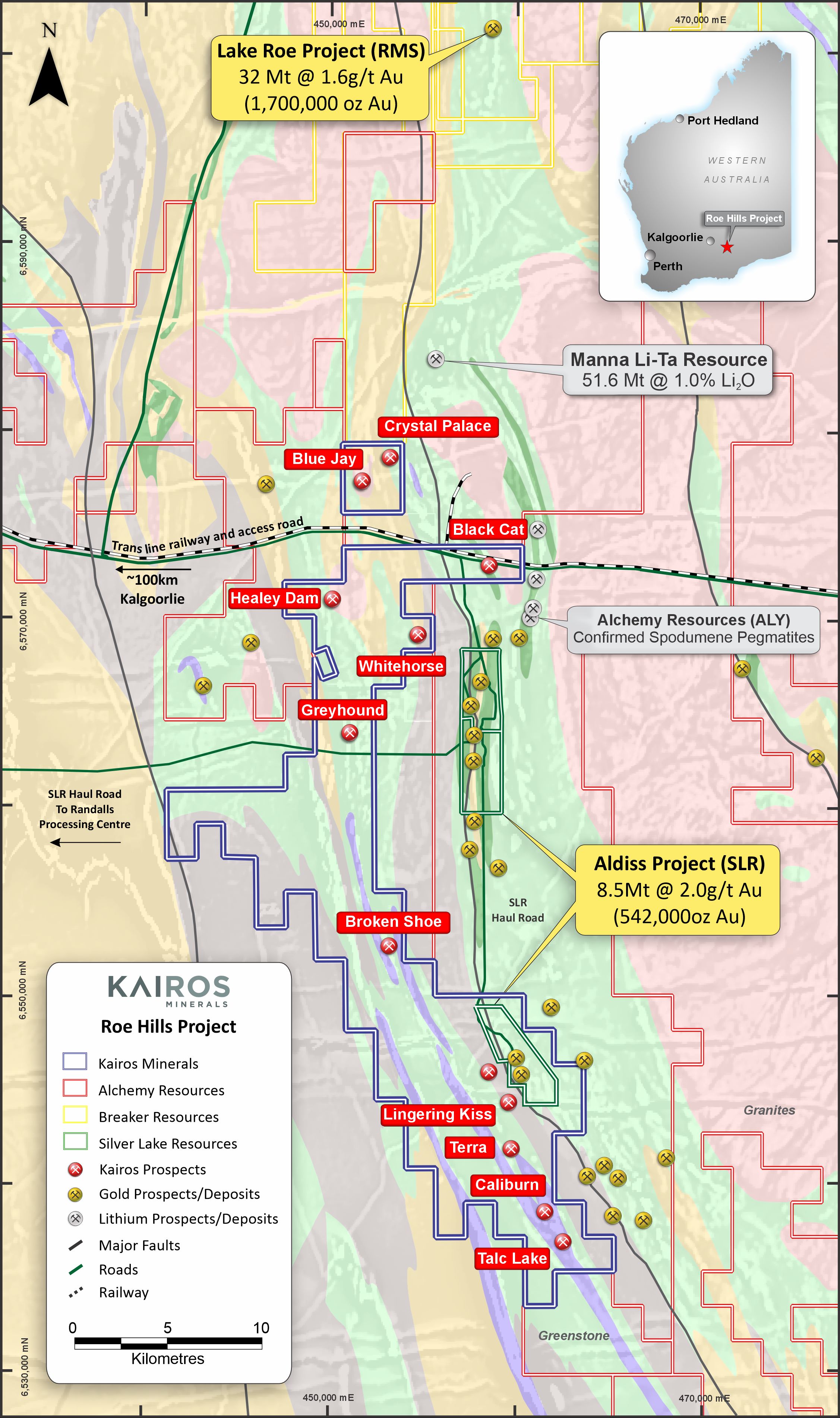
Figure 6. Geology and mineral occurrences of the Roe Hills area.
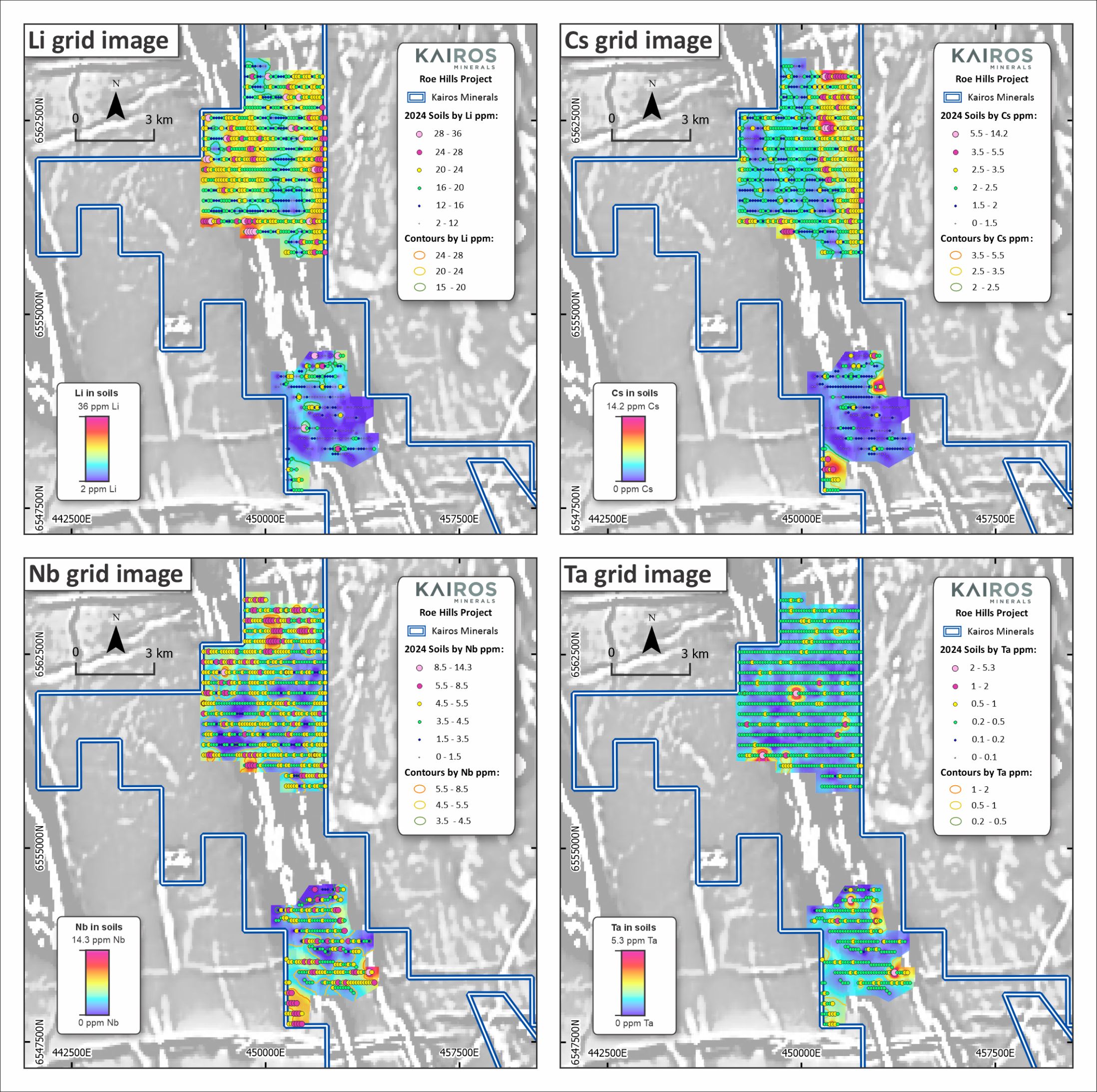
Figure 7. Roe Hills Li-Cs-Nb-Ta auger anomalies at Roe Hills.
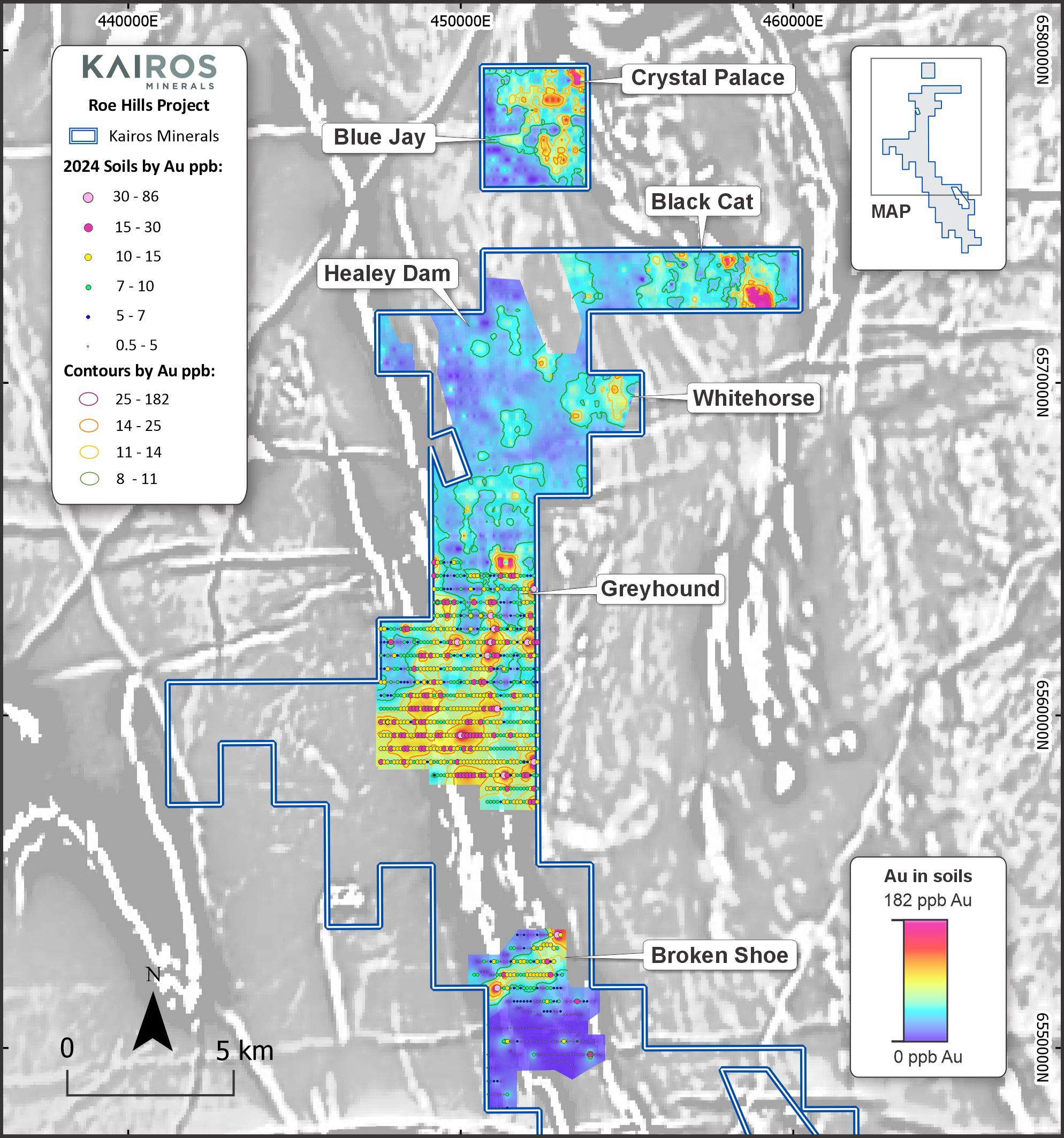
Figure 8. Roe Hills gold anomalies and prospects.
Roe Hills Rare Earth Element (REE) Discovery (Kairos 100%)
Drilling at the Black Cat Prospect in 2023 intercepted high-grade, clay-hosted light- and heavy-REEs. At the time, Kairos was drilling for lithium. Some of the drill results include:
28m @ 3854ppm TREO from 32m incl 4m @ 23,182ppm TREO from 56m (RHRC253)
48m @ 1631ppm TREO from 44m incl 12m @ 4332ppm TREO from 48m (RHRC153)
36m @ 1586ppm TREO from 36m incl 12m @ 3187ppm TREO from 44m (RHRH125)
20m @ 2100ppm TREO from 44m incl 8m @ 3152ppm TREO from 48m (RHRC126)
114m @ 1185ppm TREO from 40m incl 12m @ 2533ppm TREO from 40m and 16m @ 2178ppm TREO from 108m (RHRC127)
36m @ 1826ppm TREO from 36m incl 24m @ 2390ppm TREO from 40m (RHRC128)
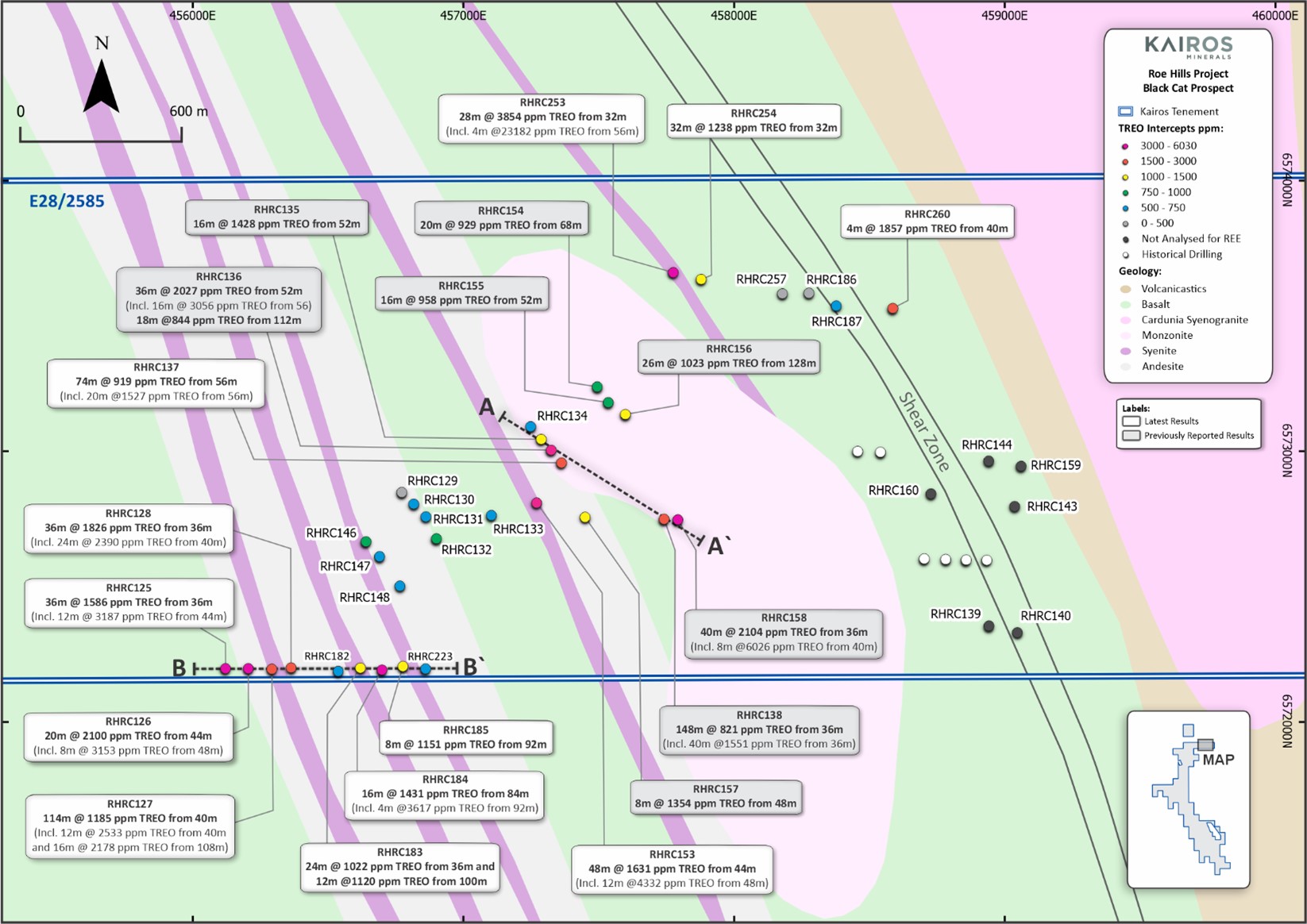
Figure 9. Black Cat REE drill results.
Interpretation of a follow-up gravity survey confirms that the REE mineralisation is related to buried syenitic intrusives that are not visible from surface. The potential resource of the REEs is very large indeed and the project will be driven by a second stage of metallurgical testwork after leach results suggest leach recoveries of up to 97% and no refractory elements, unlike most other clay-hosted REE deposits.
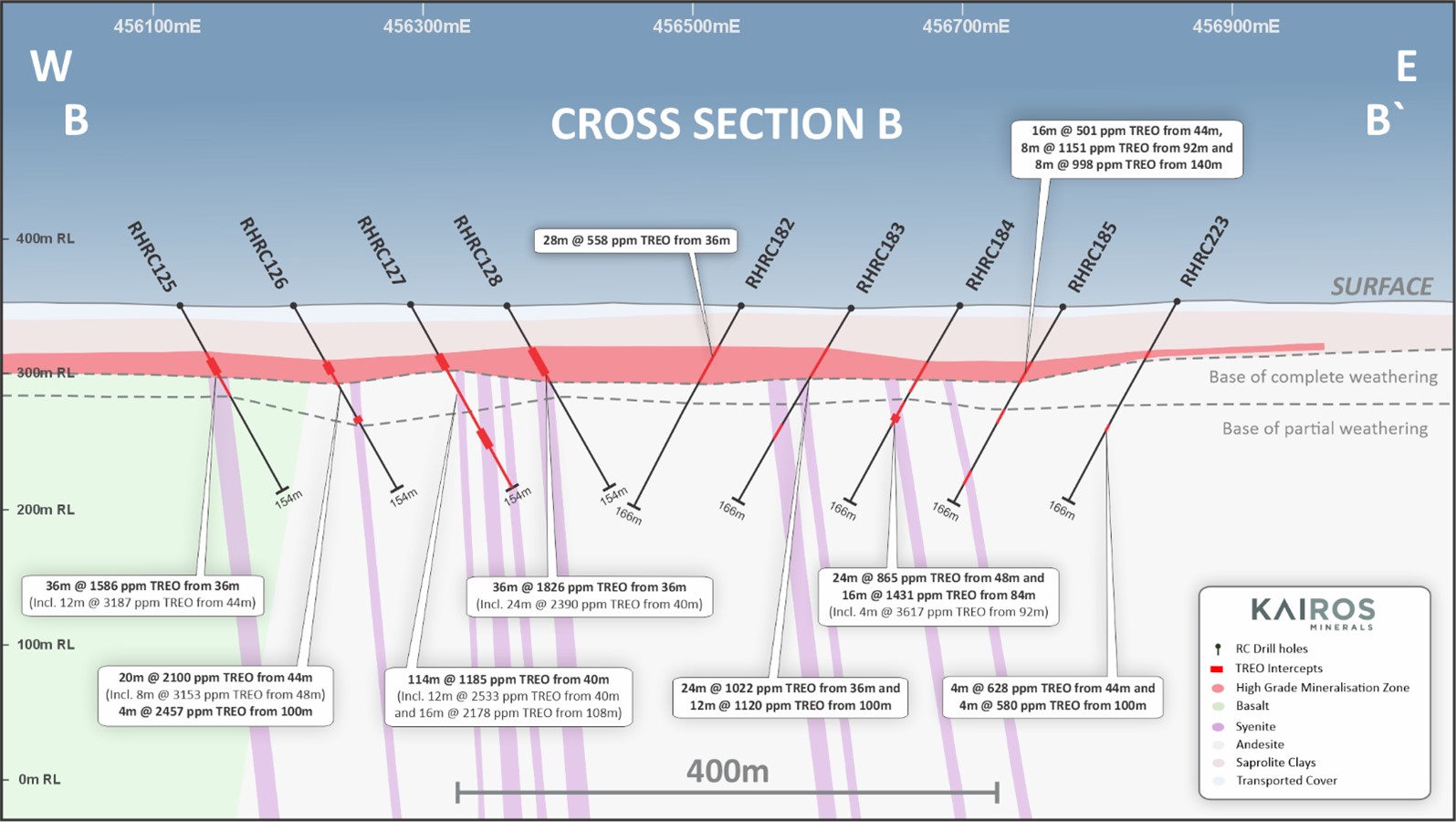
Figure 10. Cross-section B-B' with REE results. See Figure 9 for location

